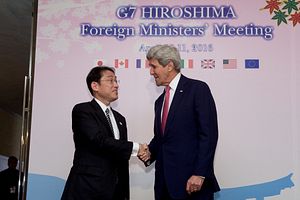The G7 meeting held in Hiroshima last weekend marks a major diplomatic accomplishment for Japan. In addition to their Joint Communique, appropriate to the location of the meeting, the G7 foreign ministers adopted the Hiroshima Declaration on Nuclear Non-Proliferation and Disarmament following the meeting. Two additional statements–one on maritime security and the other on general non-proliferation and disarmament—were also adopted.
All the media attention was on U.S. Secretary of State John Kerry’s visit to the Hiroshima Peace Memorial Museum and his reaction afterwards. Following Kerry’s visit, the focus of the debate in the United States now is whether President Barack Obama should visit Hiroshima while in Japan next month to attend the G7 Summit in Ise-Shima. In a way, this initial reaction is understandable. Hiroshima, along with Nagasaki, has long been an iconic symbol for nuclear disarmament. At the same time, at least in the United States, these two cities have often resurrected a heated debate on whether the use of atomic bombs at the end of World War II was justified. Kerry’s careful avoidance of any reference to the U.S. use of atomic bombs against Hiroshima and Nagasaki speaks to the reality in the United States that this fateful decision remains extremely sensitive politically.
Unfortunately, however, the focus on Kerry’s — and the other G7 foreign ministers’ — visit to Hiroshima Peace Memorial Museum and the Peace Memorial Park overshadowed the quite impressive results including the Joint Communique and Declarations that were adopted, and which did not attract much attention. This is very unfortunate for Tokyo. What Japanese Foreign Minister Fumio Kishida managed to orchestrate and produce at the end of the foreign minister’s meeting is a major foreign policy accomplishment for Japan, for which Kishida deserves much greater attention and credit.
This year’s G7 foreign ministers’ meeting took place against the backdrop of major developments—including terrorist attacks and North Korea’s nuclear and missile tests—in the security environment, which reaffirmed the diversity and gravity of current security challenges. In Asia, North Korea’s provocative behavior has been intensifying, as can be seen in their nuclear and missile tests earlier in the year, while China’s land reclamation and related activities in the South China Sea have continued unabated. In addition, terrorist activities by the so-called Islamic State (ISIS) and its supporters in and outside the Middle East have created ripple effects in the rest of the world, including contributing to the ongoing refugee crisis in Europe. The recent terrorist attack in Belgium is another reminder of the increasingly transnational nature of today’s security challenges.
Against this backdrop, Kishida, as the chair of the G7 foreign ministers’ meeting, had a difficult balancing act. On the one hand, as the chair of the G7 meeting, he had to make sure that the Joint Communique, the centerpiece of the meeting, addressed the world leaders’ most urgent security concern: the intensifying threat from Islamic extremist groups such as ISIS. On the other hand, he also had a strong interest in ensuring that the issues that are of particular interest to Japan—such as maritime security—were highlighted in the discussion. Finally, as a politician from Hiroshima, Kishida had a keen personal interest in making sure that nuclear disarmament was addressed.
Kishida pulled off this difficult balancing act tactfully. The Joint Communique not only featured the threat of Islamic extremist as the central concern of the G7 foreign ministers, but it also incorporated the discussion at the Nuclear Security Summit, demonstrating the linkage between counter-terrorism and nuclear non-proliferation. The additional documents adopted—on maritime security, nuclear disarmament, and non-proliferation and disarmament–reflected concerns that Japan has been keen to highlight. In particular, getting Germany and France to support stronger language on maritime security issues (albeit without identifying specific countries) was a major achievement.
The personal rapport Kishida has built with U.S. Secretary of State John Kerry since Kerry came into office, most vividly demonstrated in the image of Kerry reaching out to Kishida in front of the Hiroshima Peace Memorial Park, was also no doubt critical in his success. But furthermore it also speaks of the effectiveness of Kishida’s style. Being among the longest-serving cabinet member in Prime Minister Shinzo Abe’s government, his often low-key but pragmatic approach has turned out to be extremely effective in handling sensitive diplomatic issues, including a landmark agreement with South Korea on the “comfort women” issue.
Understandably, the world’s attention has focused on the image of all the G7 foreign ministers at the Peace Memorial Museum and the Peace Memorial Park while in Hiroshima. Without Kishida’s careful approach, however, neither this image nor the concrete diplomatic accomplishments in the meeting would have been possible.

































